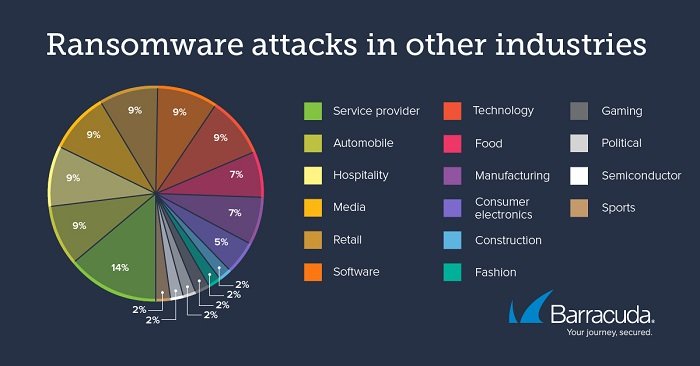India, August 26, 2022: Barracuda, a trusted partner and leading provider of cloud-first security solutions, today released its fourth-annual threat research report on ransomware. The new report looks at ransomware attack patterns that occurred between August 2021 and July 2022.
A closer look at ransomware trends
For the 106 highly publicised attacks analysed by the researchers, the dominant targets are still five key industries: education (15%), municipalities (12%), healthcare (12%), infrastructure (8%), and financial (6%):
The number of ransomware attacks increased year-over-year across each of these five industry verticals, and attacks against other industries more than doubled compared to last year’s report.
While attacks on municipalities increased only slightly, Barracuda analysis over the past 12 months showed that ransomware attacks on educational institutions more than doubled, and attacks on the healthcare and financial verticals tripled.
This year, Barracuda researchers dug in deeper on the highly publicized attacks to see which other industries are starting to be targeted. Service providers were hit the most, and ransomware attacks on automobile, hospitality, media, retail, software, and technology organizations all increased as well.
Most ransomware attacks don’t make headlines, though. Many victims choose not to disclose when they get hit, and the attacks are often sophisticated and extremely hard to handle for small businesses. To get a closer look at how ransomware is affecting small businesses, the report details three examples that researchers have seen through Barracuda SOC-as-a-Service, the anatomy of each attack, and the solutions that can help stop these attacks.
Parag Khurana, Country Manager, Barracuda Networks India, said, “Ransomware attackers remain defiant and continue to operate their business with extended extortion attempts. As ransomware and other cyberthreats continue to evolve, the need for adequate security solutions has never been greater. Many cybercriminals target small businesses to gain access to larger organisations. As a result, it is essential for security providers to create products that are easy to use and implement, regardless of a company’s size. Additionally, sophisticated security technologies should be available as services, so businesses of all sizes can protect themselves against these ever-changing threats. By making security solutions more accessible and user-friendly, the entire industry can help to better defend against ransomware and other cyberattacks.”
To safeguard their network against this type of attack, businesses should implement execution prevention by disabling macro scripts from Microsoft Office files transmitted via email. They should also carry out a robust network segmentation to help reduce the spread of ransomware if it does get into the system. Additionally, they should identify and remove any unused or unauthorised software, particularly on remote desktops or remote monitoring, as they could be signs of compromise. Organisations should also secure their web applications from malicious hackers and bad bots by enabling web application and API protection services, including distributed denial of service (DDoS) protection.
